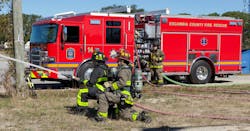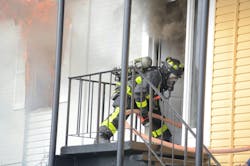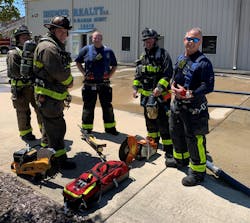Command & Control Success: Staffing's Effect on Fireground Strategies
Key Takeaways
- Fireground commanders must not make the mistake of thinking of only apparatus and equipment when they consider “resources” to build their plan of attack. They also must consider staffing that’s on scene and en route.
- NFPA 1710 and other similar standards lay out the staffing requirements for fire suppression operations, but the number of members of many departments prevent those agencies from complying with the standards. These departments’ fireground commanders must evaluate strategic options based on what’s within their means.
- Having just one additional firefighter beyond the typical three-firefighter crew of an engine company can make a huge difference in what can be accomplished on the fireground.
So many times, fire officers/fireground commanders consider resources from the perspective of fire companies alone. However, different companies offer different types of resources and staffing.
The dictionary definition of resource is “a stock or supply of money, materials, staff and other assets that can be drawn on by a person or organization to function effectively.” When fireground commanders think of “stock or supply,” they should be thinking length of ladders, how many ladders and how much water is carried. Further, is the company staffed with two, three or four firefighters?
Details matter when we’re talking resources and staffing to mitigate an incident. You must be sure to add all of your resources on a multicompany incident—total supply of tank water, total number of aerial and ground ladders, and the number of on-scene personnel—and utilize those available resources to produce the best possible outcome.
Resources also can be an action or strategy that might be adopted in adverse circumstances. So, when commanding an incident, your available resources absolutely could determine your strategy. Different levels of resources will allow different strategies as options. The more limited the resources, the more limited your strategic options will be.
Standards vs. one’s means
Historically speaking, most strategy and tactics manuals were written by urban fire officers who had large amounts of resources, including staffing, in close proximity. Fireground commanders who have limited resources most likely can’t tactically support an aggressive strategy on a large building fire—perhaps limited to only a few firefighters who are operating off of tank water because of no hydrants or limited hydrant supply.
When fireground commanders are limited to low staffing and a restricted amount of tools and equipment, they must employ tactical options that are dictated by those limitations—for example, the driver operating the top-mounted deck gun that has a gate valve installed. They might be forced to protect exposures and stay exterior/defensive.
I have talked in this column in the past about staffing standards, such as NFPA 1710: Standard for the Organization and Deployment of Fire Suppression Operations, Emergency Medical Operations, and Special Operations to the Public by Career Fire Departments. However, not all departments can comply with them. When you can’t comply, you must evaluate your strategic options based on what you can do within your means.
Build the plan around the resources and staffing. Don’t build a plan based on a particular firefighting manual that utilizes urban-size department resources and staffing. Doing the latter sets you up to fail, instead of having command success. Command success is built largely around utilizing strategy and tactics that fit available resources and staffing.
When we evaluate the difference between a three-person fire company and a four-person fire company, there’s a 25 percent difference in staffing. The “power of one” is very obvious. What one additional firefighter can provide on the fireground could be the difference between an attack line making it to the second floor of a private dwelling fire or not making it, based on pinch points.
That one additional crew member might be the one firefighter who can vent, enter and search.
Effect on capabilities
There are so many variables when talking about the power of one more firefighter, but a lot of the time, it’s the difference between three, four, five or maybe even more, depending on the department staffing and location within the city or county response area.
When responding, fire officers should have a rough idea of what the total number of firefighters responding is. In June 2025 in DeKalb County, GA, a firefighter was trapped when a building that was on fire collapsed on him as he operated outside. There were 25 firefighters operating at this fire who were able to immediately start working to free him from the collapse. He was burned, but he survived and will recover.
What if this same incident happens when only eight firefighters are available? This would definitely change the capabilities and how long that it would take to free the trapped firefighter.
Force-multiplied
A three-person engine company can effectively stretch and operate one 1¾-inch attack line without any pinch points for five minutes off of tank water. This is rather common for an engine companies across the United States. When a second fire company that’s designed the same arrives and has three firefighters, it can double the flow time of the original pumper, with the second driver providing tank water via the booster backup. The driver of the second pumper also can assist the first driver and get some tools and equipment laid out. The officer and firefighter who are on the second-arriving pumper can perform the primary search.
What results is a two-pumper attack that comprises a total of six firefighters: the first three firefighters assigned to fire attack and the next three firefighters supporting the attack via additional water supply and also getting the primary search for life started.
When the same type of first-arriving engine company is staffed with four members, you have an additional 25 percent staffing, as noted above. This is a key factor when the strategy is offensive/interior fire attack.
The fourth firefighter can be assigned as the door position/to manage pinch points, to allow the line to move in on a fire more rapidly. The fourth firefighter also can be used to catch a hydrant and establish a sustained water supply, so you can operate longer than five minutes or flow a larger amount of water.
When a second four-member company arrives, you have force-multiplied and added numerous tactical options, which could change strategic capabilities. The fourth firefighter who is on the second-arriving pumper could be left at the hydrant on the way in, to secure a sustained water supply, without delaying the arrival of the first pumper and getting water on the fire.
In 2025, we’re talking about fewer than four minutes from ignition to flashover of a single room in a residential-type building. This same room fire in 1970 was nearly 30 minutes to flashover.
Today, we’re forced to try to buy back 26 minutes through more rapidly deployed tactics, such as getting water on the fire.
We also learned recently from Fire Safety Research Institute search studies that we must locate and remove any trapped occupants more rapidly.
These are a few examples of why resources and staffing are critical for commanding for success.
Having just one additional firefighter on the first two arriving fire companies can be a huge difference in what you can accomplish, to buy back the 26-plus minutes that we no longer have: two more firefighters for a faster attack, flowing more water, or two additional firefighters to conduct a search and have it completed in a shorter period of time. We might even split it: one additional firefighter for the attack and one additional for search.
Life or death
Options are what we are looking for when we think about resources and staffing. Staffing of a particular fire company is a resource/asset to the overall incident. If we took a full box alarm assignment of five companies that all had four-person staffing (instead of three-person staffing), we are talking a total of five additional firefighters as part of the overall resources that are available to determine strategic and tactical capabilities. Five firefighters can do numerous tactical assaults on a building fire that could be the difference between life and death. These five additional firefighters might be necessary at an apartment building fire to throw ladders and make ladder rescues.
The matter of life or death is both civilian and firefighter. Five additional firefighters assigned as a RIT would be immense in the event of a mayday or firefighter emergency.
It’s critical that fireground commanders look at the numbers of all resource types, including staffing, and not just the apparatus resources in the mission for command success.
About the Author

Curt Isakson
Curt “Ike” Isakson is a 30-plus-year veteran of the fire service. He worked for Escambia County, FL, Fire Rescue for 25 years. Isakson previously worked nine years for the Pensacola, FL, Fire Department, where he was assigned as a company officer on Heavy Rescue 31. His fire service experience started at a young age as a junior firefighter with the Midway, FL, Fire District; he rose through the ranks to captain. Isakson's identification of the need for a series of special-interest fire conferences spawned the development of County Fire Tactics, which covers officer development, command officers, water on fire, high-rise operations, and leadership and tactics.


